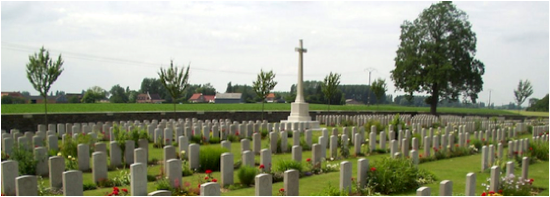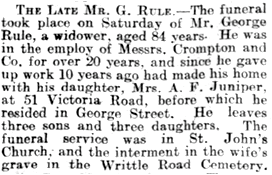Sidney Walter Rule was born and brought up in the Moulsham area of Chelmsford. He worked at Hoffmann’s bearings factory and before the war he served in the army and then left. He was recalled to the army at the outbreak of war in August 1914. He was killed in action in the First Battle of Ypres in November 1914. His home was in George Street. A brother-in-law of his was also killed during the war.
Sidney was born in Chelmsford on 2nd December 1882, the son of George Rule and Mary Ann Rule (nee Chapman). He was baptised on 10th January 1883 at St. John’s Church in Moulsham, at which time his father was a labourer living in George Street, Chelmsford.
Sidney’s father had been born in 1851 in Stansted, his mother c1851 in Widford. They married on Christmas Eve 1876 at St. John’s Church, Moulsham, when they were both living in Moulsham Street, Chelmsford. In 1881 they had been living in George Street, Chelmsford.
Sidney’s eight siblings were George Rule (born c1875), Charles William Rule (1878-1946), Emma Anna Rule (born in 1880 and baptised at St. John’s Church, Moulsham on 6th November 1880), Harriet Rule (born in 1885 and baptised at St. John’s Church, Moulsham on 4th March 1886), Lily Eliza Rule (born in 1888 and baptised at St. John’s Church, Moulsham on 25th June 1889), Arthur Rule (born in 1890 and baptised at St. John’s Church, Moulsham on 2nd May 1891), and Frederick Rule (born in 1893 and baptised at St. John’s Church, Moulsham on 26th July 1893). All the children were born in Chelmsford.
Sidney was educated at Moulsham Infants School in Moulsham Street, Chelmsford from 4th January 1886 to 29th January 1890 - at which time he lived at 7 George Street.
The 1891 census found eight year-old Sidney with his family at 39 George Street. Sidney’s father was a labourer on the roads; his eldest two siblings were a general labourer and errand boy. Ten years later the next census recorded Sidney as a private in the militia (infantry) stationed at Colchester. His parents and younger siblings were still at George Street.
In 1911 the census listed Sidney living with his parents and two younger brothers at 35 George Street. His father was an engineer’s labourer, a trade that Sidney also undertook. His brother Arthur was a fishmonger’s labourer, while brother Frederick was a maltster’s labourer.
At the time of enlistment at Warley Sidney lived at Chelmsford. He had served in India before the War and was recalled from the reserves at its outbreak. His battalion, the 2nd Battalion of the Essex Regiment (‘the Pompadours’) had been at Sheerness in Kent at the outbreak of the war and after spending time in Cromer and Norwich in Norfolk, then Harrow in Middlesex, it crossed from Southampton and landed in Le Havre on 24th August 1914. Sidney landed in France and by the time he joined his comrades the 2nd Battalion of the Essex Regiment was involved in the Battle of Le Cateau.
Over the late summer and autumn Sidney would have fought with the battalion at the Battle of the Marne, and the Battle of the Ainse. In October 1914 the battalion moved northwards to Flanders where it participated in the First Battle of Ypres. At the end of the month the battalion was near Armentieres. A post-war history of the battalion reported:
“At 6 p.m. on the 28th the Pompadours relieved the Inniskillings in the trenches about 1,000 yards south of Port Egal farm railway crossing. Although the enemy’s snipers were active all day on the 29th, little damage was done, the casualties comprising of one killed and two wounded.
The Battalion should have been relieved by the Inniskillings the next day, but the latter had to be hurried to the support of the 11th Brigade. In the early morning of October 31st the enemy attack but the movement had no heart in it and was repulsed without loss. The closing days of the Battle of Ypres constituted a period of great anxiety to the III Corps on account of the extended front, absence of reserves and the exhaustion of the troops. They also brought very heavy shelling for the Essex, who suffered several casualties.
On November 1st the snipers were very active and there was gun-fire on the forward trenches. One shell pitched into a party of ‘A’ Company, killing three and wounding one, whilst two others were killed and two wounded, but on the 3rd the artillery was quiet, although the same number of casualties occurred.”
RULE, SIDNEY WALTER,
Private, 2nd Battalion, Essex Regiment
It was during this period that Sidney lost his life - killed in action on 2nd November 1914, while serving as Private 7463. He was shot through the neck.
Today he lies at Ration Farm Military Cemetery, La Chapelle-D'Armentieres, Nord, France (grave: VII. A. 22) close to the grave of another Chelmsford man Stanley Etheridge.
The Essex Weekly News of 27th November 1914 reported:
“Pte. S. Rule, Essex Regt., who has been killed in action, was the third son of Mr. and Mrs. G. Rule, George-street, Chelmsford. Deceased, who was 32 years of age, had formerly served in India. At the outbreak of war he was in the reserve, and had for some time been employed at the Hoffmann Works.”
The same edition mentioned Sidney in another report:
"Mrs. A. Linge of Baker's-yard, George Street, Chelmsford, has received a letter from a lady in Boulogne stating that her husband, Pte. A. Linge of the Essex Regt, is wounded and in Boulogne hospital. In a recent letter to his wife , dated Nov. 5, he said ‘Am having a rest for a few days from the trenches. Young Rule of Chelmsford, who you saw at Harwich, is dead, shot through the neck three days ago. The same way three men in our section got buried through a shell coming into the trench, making it cave in. We dug them out alive, the Germans shelling us all the time’.”
Sidney is commemorated on the Civic Centre Memorial, Chelmsford, and the Moulsham Parish Memorial, St John’s Church, Moulsham. Sidney was entitled to the 1914-15 Star, British War Medal, and Victory Medal.
On 23rd April 1917 Sidney’s brother-in-law, Arthur Frederick Juniper (husband of his sister Harriet), was killed in action while serving with the Norfolk Regiment.
The 1918 register of electors showed George’s parents still at 35 George Street. The road survives today as a car park, but almost all the original houses have been demolished.
Sidney’s mother died in 1925; his father died in 1936, aged 84.
131213

